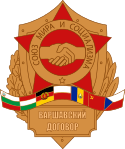Brașov Rebellion
| Brașov Rebellion | |
|---|---|
 15 November street in Brasov in memory of the Brașov Rebellion | |
| Location | Brașov |
| Date | 15 November 1987 |
| Target | Communist headquarters and city hall |
| Perpetrators | Workers from Steagul Roșu plant, Tractor Plant, Hidromecanica factory |
Number of participants | 20,000 workers |
| Defenders | Securitate forces and Romanian Army |
The Rebellion of Brașov was a revolt against Nicolae Ceaușescu's economic policies in Communist Romania, which erupted on the day of the 1987 local election.
Prelude
| Eastern Bloc |
|---|
 |
|
Allied states |
|
Dissent and opposition 1953 uprisings
1956 protests
|
Beginning in late 1986, the seeds of the Romanian Revolution of 1989 were sown, as workers throughout this Soviet Bloc country mobilized in protest of communist leader Nicolae Ceauşescu's economic policies. Labor uprisings sprouted in the major industrial centers of Cluj-Napoca (November 1986) and Nicolina, Iași (February 1987), culminating in a massive strike in Brașov, one of the largest cities in Romania. Ceaușescu's draconian economic measures sought to curb food and energy consumption and reduce worker's wages, leading to what Romanian émigré Vladimir Tismăneanu calls an "all pervasive discontent," making Romania "the Eastern Bloc country most vulnerable to revolution."
Though Romania was the last of the Eastern European communist strongholds to succumb to revolution in 1989, his sentiments capture the social and economic volatility of Romania in the late 1980s. The Brașov Revolt reflected this instability; moreover, it was one of the first large-scale public uprisings against the Ceaușescu regime.
Located in southeastern Transylvania, Brașov was Romania's most industrially developed city, with over 61% of labor participating in industry. A skilled working class emerged in the 1960s as the Communist government encouraged migrations from the more rural regions of Romania (such as Moldavia) to operate Brașov factories. Therefore, the industrial decline in Eastern Europe during the mid-1980s hit Brașov and its workers especially hard.
Ceaușescu's debt reduction plan beginning in 1982 led to the collapse of the consumer market of the city. Money intended for food production and distribution was in turn diverted to debt payment to the West. Therefore, the state rationed key foodstuff and consumer goods, leading to long lines for the most basic commodities. It is in this climate of economic depression and food shortages that the Brașov rebellion erupted on 15 November 1987.
Rebellion
Early on the morning of the 15th, a local elections day, workers at the local Steagul Roșu plant (truck manufacturer) protested reduced salaries and the proposed elimination of 15,000 jobs in the city. Roughly 20,000 workers walked off the job and marched toward the Communist headquarters at the city center. Firstly, the demonstrators expressed loudly wage claims, then they shouted slogans like “Down with Ceaușescu!”, “Down with Communism!”, chanting anthems of the 1848 Revolution "Down with the Dictatorship" and "We want bread."
Over 20,000 workers from the Brașov Tractor Plant, Hidromecanica factory and a number of townspeople joined the march. The combined mob sacked the headquarters building and city hall "throwing into the square portraits of Ceaușescu, and food from the well-stocked canteen." In a time of drastic food shortages, protesters were particularly angered to find festively prepared official buildings and food abundance in order to celebrate the local election victory. A massive bonfire of party records and propaganda burned for hours in the city square.
By dusk, Securitate forces and the military surrounded the city center and disbanded the revolt by force. Though no one was killed, some 300 protesters were arrested. However, since the regime decided to play down the uprising as “isolated cases of hooliganism,” sentences did not exceed 2 years prison, which was a relatively moderate penalty in the communist penal code. After 1990, up to 100 prison convictions could be documented so far, while others had been forcibly relocated throughout the country.
Though the Brașov Rebellion did not directly lead to revolution, it dealt a serious blow to the Ceaușescu regime, and its confidence in the trade unions. This revolt reflected what historian Denis Deletant refers to as "Ceaușescu's inability to heed the warning signs of increasing labor unrest, plunging blindly forward with the same [economic] measures, seemingly indifferent to their consequences." Therefore, the Brașov Rebellion underscored the growing discontent among workers against the Ceaușescu regime; moreover, it foreshadowed the popular uprisings that would bring down the regime and Communism in Romania only two years later. (Rebellion returned to Brașov in December 1989, while Romanians ousted the regime and executed Ceaușescu.)
References
- Deletant, Denis. "Romania, 1948-1989: A Historical Overview", 35-36, Parallel History Project on NATO and the Warsaw Pact.
- Keil, Thomas J.. "The State and Labor Conflict in Post-Revolutionary Romania", Radical History Review, Issue 82 (Winter 2002), pp. 9–36.
- Kuran, Timur. "Now Out of Never: The Element of Surprise in the East European Revolution of 1989." World Politics, Vol. 44, No. 1. (October 1991), pp. 7–48.
- Nelson, Daniel. "The Worker and Political Alienation in Communist Europe", Polity Journal, Vol. 10, No.3, 1978, pp. 1–12.
- Socor, Vladimir. "The Workers' Protest in Brașov: Assessment and Aftermath", Romania Background Report 231, Radio Free Europe Research, 4 December 1987, pp. 3–10.